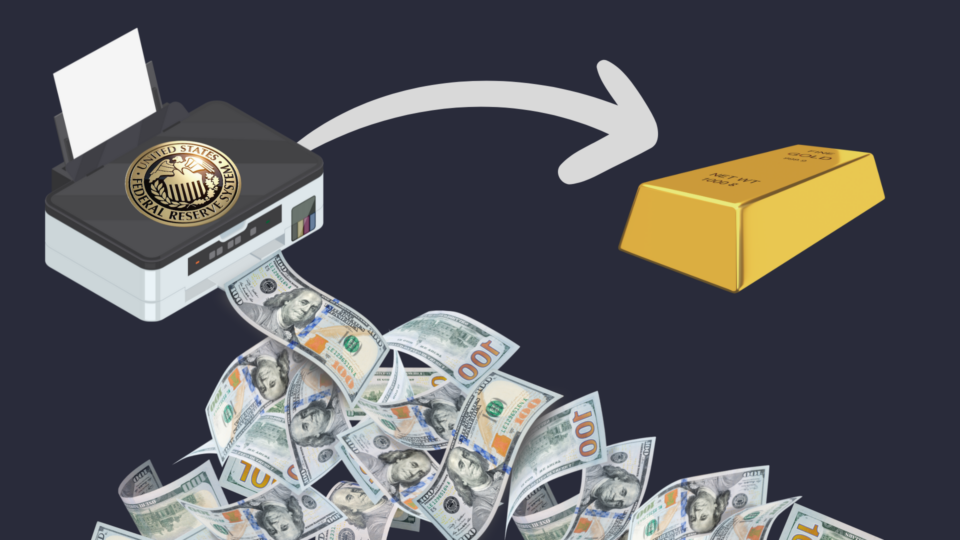The long-term risks of quantitative easing, including eroding the credibility of the US dollar, are closely linked to gold's performance.
What is Quantitative Easing?
Quantitative easing (QE) is a strategy designed to stimulate the economy when all other options (such as lowering interest rates) have been exhausted.
Step 1: The Fed purchases government bonds in the open market. To do this, the Fed creates reserves out of thin air and credits them to the account of the bank selling the bonds.
Step 2: Banks use these new reserves to give out loans. The effect is two-fold: increasing the money supply (because borrowers have new money in their pockets) and suppressing interest rates (due to the greater supply of loans).
For a comprehensive understanding of how the Fed and commercial banks create money, please refer to this article: A Guide to How Banks Create Money (for Visual Learners)
How Quantitative Easing Impacts Gold
There is no statistically significant relationship between the short-term price of gold and QE programs. However, the negative long-term effects of QE align perfectly with the factors that drive gold higher.
Rising Inflation
When the central bank pumps money into the system, every dollar in circulation decreases in value. People may feel richer, but ultimately the deteriorating currency eats away their extra purchasing power.
The inflationary pressures of QE are not always immediate. For example, following the Global Financial Crisis of ’08-’09 and subsequent QE programs, consumer inflation stayed relatively low.
This is because most banks kept the newly created reserves parked on their balance sheets rather than circulating them via loans.
Still, in the long run, an increase in the money supply inevitably translates to higher costs of goods and services and an increase in the price of gold.
Asset Bubbles
When banks inject new money into the system, it often ends up allocated to unproductive assets and companies. Economists call this the “malinvestment problem.”
Not only does this inflame wealth inequality (free money ends up in the pockets of those who already own assets), but it also increases market volatility.
Gold benefits from asset bubbles as a form of financial insurance and a market hedge. When bubbles pop, investors clamour for the safety that precious metals provide.
Debt Crises
Credit feels a lot like currency. You can spend it like currency. When your bank account increases by $10, it feels the same as holding a new $10 bill.
But credit is not currency. When credit is created through the lending process, the borrower is endowed with new purchasing power, but he also takes on a future debt burden.
New purchasing power is not created; it is shifted from the future to the present. When the future finally arrives, there might not be any purchasing power left. To stay solvent, consumers, businesses, and governments must acquire more and more debt, pulling more and more purchasing power from even further in the future.
This explains the massive increase in both public and private debt in recent decades.
At some point, public and private borrowers will fail to find lenders willing to support their unquenchable thirst for credit. When the lending stops, borrowers suddenly default on their debt obligations, and credit starts evaporating from the economy.
When this happens, gold is one of the only assets that remains secure. The value of physical gold is not tied to anyone else’s solvency, which means it carries no counterparty risk. Precious metals become very attractive when debt crises appear on the horizon.
Federal Reserve Credibility
Prior to 1971, the US dollar derived its value from gold. Today’s fiat currency paradigm relies instead on the credibility of the issuing government.
What Backs the United States Dollar?
A fiat currency can function as long as economic participants have confidence in the government’s ability to repay its debts, and the ability of central bankers to make prudent decisions about interest rates, money supply, and inflation.
Unconventional monetary policy tools like QE introduce a high degree of risk to the Fed’s credibility.
Throughout history, countless governments have undermined the value of their own currency via excessive money printing. Is QE a brilliant innovation in monetary policy, or just another way to sow the seeds of monetary collapse?
Secure gold savings, without the excessive fees
Vaulted gives investors access to physical gold and silver with the tap of a finger. With personal advising from industry experts and the best cost structure in the industry, Vaulted is designed to empower your financial future.
As always, thank you so much for reading – and happy investing!











